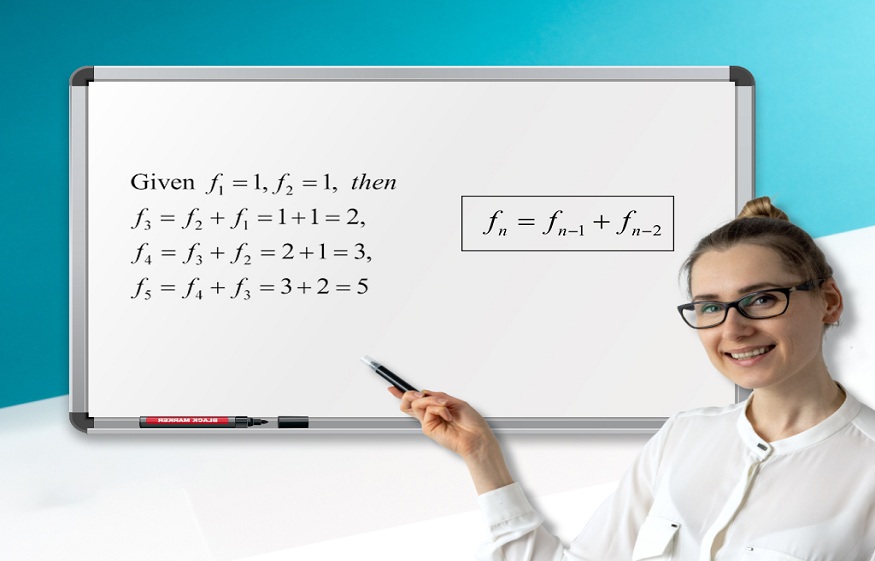A sequence in mathematics is an arrangement of numbers in a sequential manner that follows a specific rule; each term of a sequence is related to its previous and successive term by that given rule.
More formally, a sequence may be defined as a mapping or a function f: 𝐍→X defined as f(n) = xn for every n in 𝐍
such that all the xn; n = 1, 2, 3,… is a sequence in X governed by the rule f.
Some examples of a sequence are:
- Sequence 2, 6, 12, 30,… the general rule for this particular sequence is n(n + 1); n = 1, 2, 3,…
- 1, 1/2, 1/3, 1/4,… whose general rule is 1/n where n is a Natural Number.
Recursive Sequence
A recursive sequence is a sequence formed by a recursive function. Recursion is a process in which a sequence is formed by selecting an initial term to begin the sequence and repeatedly using the previous term to find the next term. Thus, recursion is a recursive function that uses the initial or preceding values to get the successive terms. There are two steps of a recursion:
Basic Step: Specifies a collection of starting values or initial values of the function.
Recursive Step: Gives the rule to form new elements based on known values or previous values of the sequence.
Sometimes an exclusion set is also defined, which specifies a set of values that are not to be included in the recursion process.
Example of a recursive sequence:
The sequence of natural numbers.
Basic Step: Let f be the recursive function whose initial value fo = 0
Recursive Step: fn = fn + 1; According to recursive rule
f1 = fo + 1 = 0 + 1
f2 = f1 + 1 = 2 and so on we get the sequence of natural numbers
Fibonacci Sequence
A prominent example of a recursive sequence is a Fibonacci Sequence. This sequence is proven to be one of the most intriguing and ubiquitous of all number sequences in mathematics. Fibonacci Sequence, also known as Fibonacci Numbers, is defined recursively as:
For n be any number, n ≥ 0, if Fn is the nth Fibonacci number, then we have
Basic Step: The initial values of the recursion, Fo= 0 and F1= 1
Recursive Step: The recurrence relation is defined as
Fn = Fn – 1 + Fn – 2 , n ≥ 2
The successive Fibonacci Numbers are found by adding the preceding two numbers of the sequence. Hence, the terms in the sequence are 0, 1, 0 + 1 = 1, 1 + 1 = 2, 1 + 2 = 3, 2 + 3 = 5, 3 + 5 = 8, 5 + 8 = 13, that is, 0, 1, 1, 2, 3, 5, 8, 13, 21, 34, 55, 89, 144 and so on.
Some Properties of Fibonacci Numbers
The number pattern has some interesting properties, which makes it such a significant number sequence.
- Successive numbers of the sequence have a recurrence relation.
- The Greatest Common Divisor of successive terms of the sequence is 1.
For n ≥ 0 and Fn be recursion function for the sequence, gcd( Fn, Fn+1) = 1. Let us check this property b taking an example, gcd(F5, F6) = gcd(5, 8) = 1 and gcd(F9, F10) = gcd(34, 55), now factors of 34 are 1, 2, 17 and 34 and factors of 55 are 1, 5, 11 and 55. Thus, gcd(34, 55) = 1.
- For n ≥ 0, gcd(Fn, Fn + 2) = 1
We can also check this one by taking an example, F5 = 5 and F5 + 2 = F7 = 13, clearly
gcd(5, 13) = 1.
- The sum of any six consecutive Fibonacci Numbers is a multiple of 4.
Let us take, F2 + F3 + F4 + F5 + F6 + F7 = 1 + 2 + 3 + 5 + 8 + 13 = 32 = 4 × 8.
- The ratio of any two consecutive Fibonacci Numbers is approximately equal to the Golden Ratio.
The value of the Golden ratio, φ = 1.618, approximately
F6 : F5 = 8 : 5 = 1.6 which is close to the Golden Ratio.

